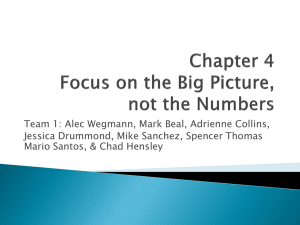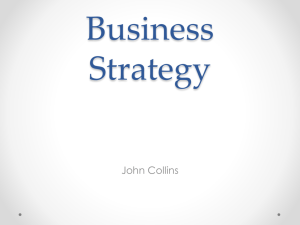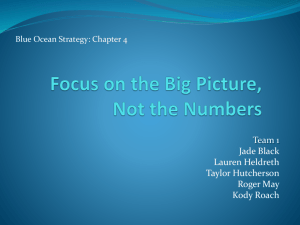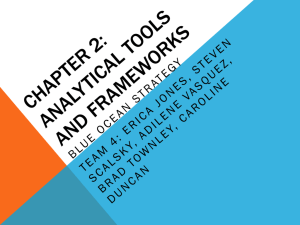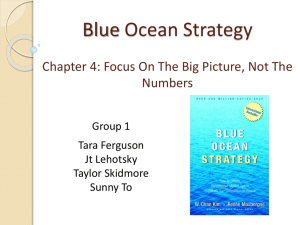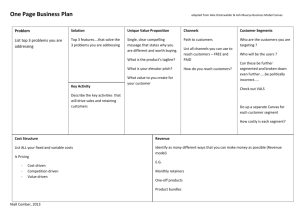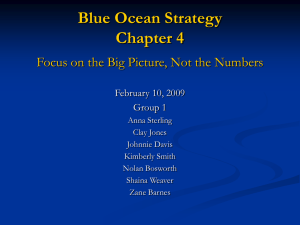Focus on the Big Picture, Not the Numbers
advertisement
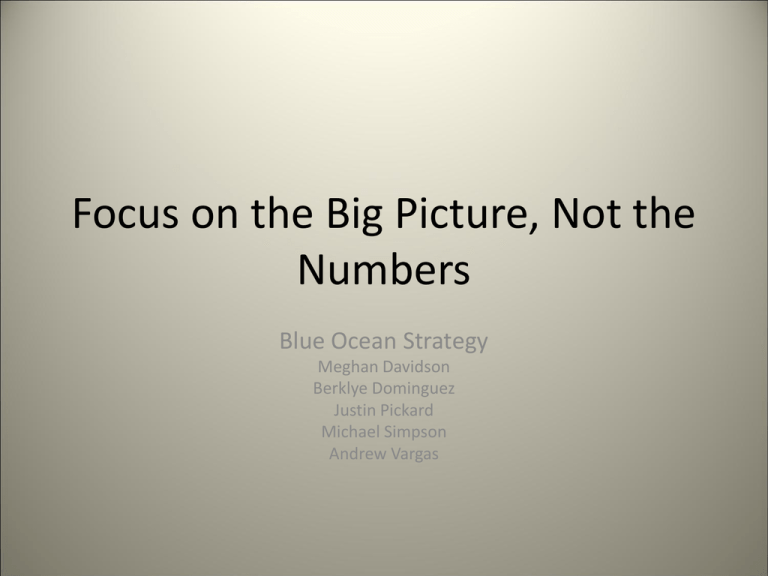
Focus on the Big Picture, Not the Numbers Blue Ocean Strategy Meghan Davidson Berklye Dominguez Justin Pickard Michael Simpson Andrew Vargas The “Typical” strategic plan • A very long document made up of mishmash data from different people of lengthy description of current industry conditions and competitive situations followed by a discussion of how to increase market shares, capture new segments, or cut costs. Then an outline of goals and budgets with graphs and spreadsheets The “Typical” Strategic Plan cont. • By doing things this way, managers spend the majority of the time filling in boxes and running numbers instead of thinking outside the box to get a clearer picture of how to break free from the competition • Most of the time few employees in the company even know what the strategy is because it is just a mix match of data that is collectively don’t add up in a clear defined direction Focus on the BIG Picture • Alternative strategy approach that consistently produces strategies that open companies eyes to blue oceans • By building a companys strategic planning process around a strategy canvas, the company focuses their main attention on the big picture rater than becoming immersed in numbers and jargon Drawing Your Strategy Canvas • Drawing strategy canvas does three things: – Shows the strategic profile of an industry by depicting very clearly the factors that affect competition among industry players – Shows the strategic profile of current and potential competitors – Company’s strategic profile-or value curvedepictiong how it invests Drawing Your Strategy Canvas • Drawing your strategy canvas can be tough because many times very few people can see the overall dynamics of their industry • For example: A CIO might prize the company’s IT system for its data-mining capacity, a feature that is not really that important to customers who are more concerned with speed and ease of use The Four Steps of Visualizing Strategy European Financial Services (EFS) developed a structured process for drawing and discussing a strategy canvas that pushes a company’s strategy toward a blue ocean 1. Visual Awakening 2. Visual Exploration 3. Visual Strategy Fair 4. Visual Communication Step 1: Visual Awakening • Compare your business with your competitors’ by drawing your “as is” strategy canvas. • See where your strategy needs to change. Common Mistakes • Discussing strategy before resolving differences • Executives are reluctant to accept change What prompted a change in strategy? • A highly determined leader • Serious Crisis – Ex: General Motors • Used a reactive instead of a proactive approach. European Financial Services (EFS) • Before implementing a Blue Ocean Strategy: – Ill-defined and poorly communicated strategy – Deeply Divided – corporate culture =“Nuts in the field, brains in the center” EFS cont. • Formed two executive teams from around the world. (Australia, America, Asia, and Europe) • Each team produced a value curve relative to its competition – Traditional business vs. Emerging Online Business • Very painful experience! EFS Strategy Canvas (offline) EFS Strategy Canvas (online) Step 2: Visual Exploration • Send team hands on approach. – How people use or don’t use products. • Managers cannot outsource the face to face interaction. – Often rely on reports from people who are not directly impacted. – “ A company should never outsource its eyes. There is not substitute for seeing for yourself.” (p. 88). Michael Bloomberg • Saw a need for providers of financial information to have data online. • Before traders use pencil, paper, and calculator. • Strategic insight allowed him to challenge the boundaries that were created. Visual Exploration Cont. • Examine the strategic need first focus on customers . • Identify the product or service can lead to bundling opportunities. – Ex: AT&T bundling wireless, internet, and cable • Alternative ways of that carry advantages and characteristics. – Ex: Driving is alternative to Flying. Collecting Data • EFS sent managers into the field to explore the paths to create a blue ocean. • Interviewed people involved with corporate foreign exchange. • Involved people and companies who could benefit from using their services. • Looked at subordinate products and services that their customers used. Evaluations from Fieldwork • Managers research showed that conclusions were inaccurate. – Account relationship managers turned out to be Achilles’ heel. – Speedy confirmation of transactions was item that customers valued most. Reworking a New Strategy • Teams sent back to propose strategy with six new value curves • Each new value curve tried to stand out • Demanded six pictures that portrayed their proposals Visual Exploration • For each visual strategy team had to write compelling tagline. • Led to competition between the two teams and process was more enjoyable in developing blue ocean strategies Visual Exploration • Hands on approach with fieldwork is important for managers. • “When you keep your hands on the objects in view, it gives you a far better idea about the object than if seen otherwise.” Washington University psychologists • Great strategic insights come from seeing what is beyond the boundaries and borders Step 3: Visual Strategy Fair • • • • • Attendees include: Senior executives Noncustomers Customers of competitors Demanding customers EFS example • 2 groups presented six strategies. • Each group had 10 minutes • Pictures of the strategy curves were hung on the wall for all to see. EFS ex. Cont. • After the groups presented, each judge had 5 sticky notes to use to pick their favorites. • Once they chose their favorites, they had to explain why they chose favorites. • They also had to explain why they did not choose the other strategies. What they learned • EFS received a level of feedback they never expected. • 1/3 of what they thought were key factors were in fact marginal to customers • They learned that they needed to reevaluate long-held assumptions. How they changed • They were able to draw a value curve that was a truer likeness of the existing strategic profile than anything they had produced earlier. • They were in a position to draw a future distinct strategy. How they changed cont. • They were able to shift focus from account executives to integration with online services. • They could offer payment tracking similar to FedEx and UPS do for parcels • “The FedEx of corporate foreign exchange: easy, reliable, fast, and trackable.” Step 4: Visual Communication • This last step is important because you are to communicate the future strategy in a way for all employees to understand. One-Page Picture • History has shown it to be very helpful to put the firm’s new and old strategic profiles on one page. • This makes it easier for all employees to see where their company has been, and where it needs to go. European Financial Services • Used the one-page picture to demonstrate to all employees • Employees could see clearly where the company was and where it needed to focus to have a promising future. • Senior managers held meetings discussing the picture and what needed to be eliminated and raised to pursue a blue ocean. European Financial Services • Employees began a positive chain passing the senior managers’ messages along. • By having a clear game plan, employees were excited and actually hung the picture up in their cubicles to remind them of new priorities. • The one-page picture became a reference point. Visual Communication cont. • This one-page reference point makes it easier for all companies to continue in the same direction. • It reminds employees of the common goals of the firm and changes bad habits into good habits. Visualizing Strategy at the Corporate Level • Greatly inform the dialogue among individual business units and the corporate center in transforming a company from a red ocean to a blue ocean player • Strategy canvases – The understanding of the other businesses in the corporate portfolio Using the Strategy Canvas • To demonstrate how this works, lets take Samsung Electronics 2000 corporate conference – Attended by more than 70 top managers – Presented their canvases and lots of heated discussion between • Top performers argued that future strategies were constrained by the degree of competition • Poor performers felt that they had little choice but to match their competitors Using the Strategy Canvas Cont. • In the end they hypothesis proved to be false when the mobile phone business presented its strategy canvas – The unit not only had a value curve but also faced the most intense competition • Now Samsung has institutionalized the strategy canvas in its key business creations by establishing Value Innovation Program (VIP) VIP • Core cross functional team members of Samsungs various business units come together in the VIP to discuss the strategic projects focusing mainly on strategy canvases • Assists the units in making their product and service offering decisions – For example: The LCD TV (worlds leading 40 inch) and the mobile phone SGH T-100 (worlds best selling mobile) VIP cont. • There is an annual Value Innovation corporate conference by all its top executives • This is one way that Samsung establishes a common language system, instilling a corporate culture and strategic norms that drive its corporate business portfolio from red to blue Using the Pioneer-Migrator-Settler (PMS) Map • Visualizing strategy can also help managers responsible for corporate strategy predict and plan the company’s future growth and profit • Especially valuable for managers who want to see beyond today’s performance • A company’s pioneers: – (blue ocean strategists) are most powerful sources of profitable growth that have a mass following of customers and their value curve diverges from the competition on the strategy canvas Pioneer-Migrator-Settler cont. • On the other hand the company’s Settler: – Me-Too business-Business whos value curve conform to the basic shape of the industry’s and will not contribute much to a company’s future growth (Stuck within the red ocean) • The Migrators lie in-between: – These business extend the industry’s curve by giving customers more for less, but don’t alter its basic shape and offer improved value but not innovative value (fall in between red and blue ocean) Using PMS • A useful exercise for corporate management profitable growth is to plot the company’s current and planned portfolios on PMS map – If current and planned portfolios consist mainly of settlers then: • (red ocean) and needs to push for value innovation – If current and planned portfolios consist mainly of migrators then: • Reasonable growth can be expected but they are not exploiting its potential fro growth – The more industry settlers, the greater opportunity to value-innovate and create blue ocean of new market space Shift the focus toward pioneers • Executives should shift the their future portfolio toward pioneer; which is the path to profitable growth • Executives should use value and innovation as important parameters for managing their portfolio – Innovation because without it companies are stuck in the trap of competitive improvements – Value because innovation ideas will be profitable Overcoming the Limitations of Strategic planning • Basically we need to focus on building the process around the big picture and eventually the details will fall into place once we focus on the big picture it will yield much better results. As Aristotle pointed out “The soul never thinks with out an image.”
